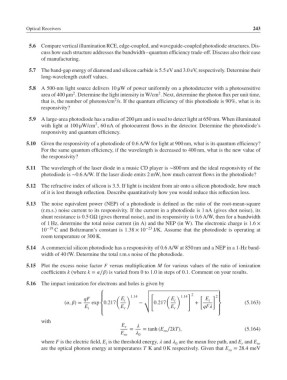Page 262 - Fiber Optic Communications Fund
P. 262
Optical Receivers 243
5.6 Compare vertical illumination RCE, edge-coupled, and waveguide-coupled photodiode structures. Dis-
cuss how each structure addresses the bandwidth–quantum efficiency trade-off. Discuss also their ease
of manufacturing.
5.7 The band-gap energy of diamond and silicon carbide is 5.5 eV and 3.0 eV, respectively. Determine their
long-wavelength cutoff values.
5.8 A 500-nm light source delivers 10 μW of power uniformly on a photodetector with a photosensitive
2
2
area of 400 μm . Determine the light intensity in W/cm . Next, determine the photon flux per unit time,
2
that is, the number of photons/cm /s. If the quantum efficiency of this photodiode is 90%, what is its
responsivity?
5.9 A large-area photodiode has a radius of 200 μm and is used to detect light at 650 nm. When illuminated
2
with light at 100 μW/cm , 60 nA of photocurrent flows in the detector. Determine the photodiode’s
responsivity and quantum efficiency.
5.10 Given the responsivity of a photodiode of 0.6 A/W for light at 900 nm, what is its quantum efficiency?
For the same quantum efficiency, if the wavelength is decreased to 400 nm, what is the new value of
the responsivity?
5.11 The wavelength of the laser diode in a music CD player is ∼800 nm and the ideal responsivity of the
photodiode is ∼0.6 A/W. If the laser diode emits 2 mW, how much current flows in the photodiode?
5.12 The refractive index of silicon is 3.5. If light is incident from air onto a silicon photodiode, how much
of it is lost through reflection. Describe quantitatively how you would reduce this reflection loss.
5.13 The noise equivalent power (NEP) of a photodiode is defined as the ratio of the root-mean-square
(r.m.s.) noise current to its responsivity. If the current in a photodiode is 1 nA (gives shot noise), its
shunt resistance is 0.5 GΩ (gives thermal noise), and its responsivity is 0.6 A/W, then for a bandwidth
of 1 Hz, determine the total noise current (in A) and the NEP (in W). The electronic charge is 1.6 ×
10 −19 C and Boltzmann’s constant is 1.38 × 10 −23 J/K. Assume that the photodiode is operating at
room temperature or 300 K.
5.14 A commercial silicon photodiode has a responsivity of 0.6 A/W at 850 nm and a NEP in a 1-Hz band-
width of 40 fW. Determine the total r.m.s noise of the photodiode.
5.15 Plot the excess noise factor F versus multiplication M for various values of the ratio of ionization
coefficients k (where k = ∕) is varied from 0 to 1.0 in steps of 0.1. Comment on your results.
5.16 The impact ionization for electrons and holes is given by
√
⎧ ( ) 1.14 √ [ ( ) 1.14 ] 2 [ ] 2 ⎫
√
qF ⎪ E i √ E i E i ⎪
(, )= exp 0.217 − √ 0.217 + (5.163)
E ⎨ E E qF ⎬
i ⎪ r r ⎪
⎩ ⎭
with
E
r
= = tanh (E ∕2kT), (5.164)
ro
E ro 0
where F is the electric field, E is the threshold energy, and are the mean free path, and E and E ro
0
r
i
are the optical phonon energy at temperatures T K and 0 K respectively. Given that E = 28.4meV
ro

